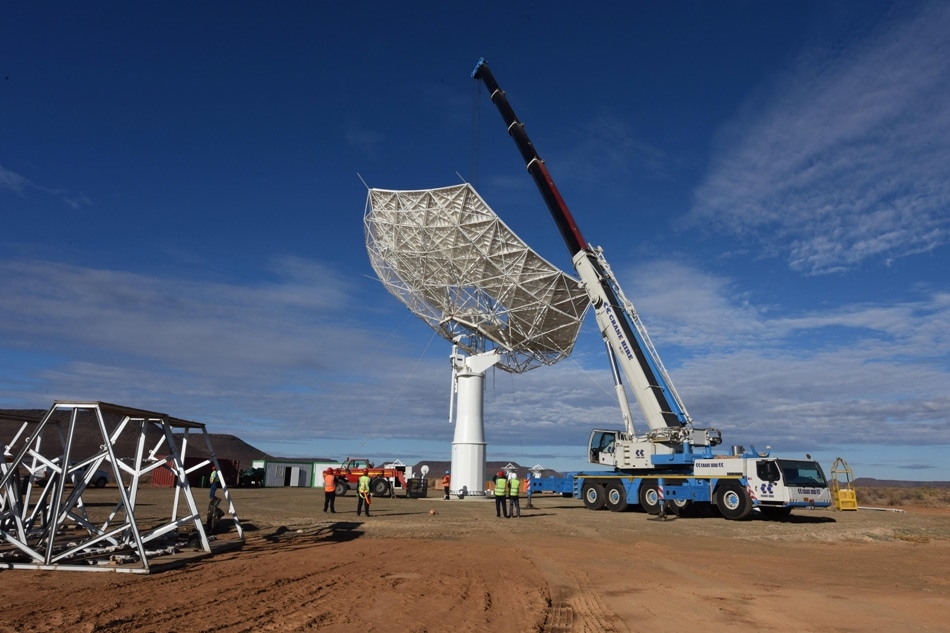Jul 25 2019
The Square Kilometer Array (SKA) is established to become the largest radio telescope on Earth.
 The SKA-MPG telescope is currently being constructed on-site in South Africa. (Image credit: South African Radio Astronomy Observatory (SARAO))
The SKA-MPG telescope is currently being constructed on-site in South Africa. (Image credit: South African Radio Astronomy Observatory (SARAO))
Scientists at Bielefeld University along with the Max Planck Institute for Radio Astronomy (MPIfR) and global collaborators have presently investigated the SKA-MPG telescope—a prototype for the part of the SKA that gets signals in the mid-frequency range.
The research reported on July 24th, 2019, in the journal Monthly Notices of the Royal Astronomical Society demonstrates that in addition to being a prototype to test the SKA design, the telescope can also be used on its own to offer insights into the beginning of the Universe.
The German Federal Ministry of Education and Research (BMBF) funds the research on the SKA-MPG via a collaborative research project coordinated by Bielefeld University.
The SKA-MPG telescope in South Africa will help us to understand the cosmic background radiation.
Dr Aritra Basu, Study Lead Author and Physicist, Astroparticle Physics and Cosmology Working Group, Bielefeld University
The cosmic background radiation is light in the microwave range that was generated soon after the Big Bang, and investigating it offers insights into the origin of the Universe.
“However, measurements of the cosmic background radiation are distorted by other effects in the foreground, such as ultrafast electrons in the magnetic field of the Milky Way. In order to measure cosmic background radiation, we need to know more about these effects. Our study shows that the new telescope is excellent for investigating foreground radiation with ultra-precision,” states Basu.
The Max Planck Institute for Radio Astronomy (MPIfR) in Bonn made the SKA-MPG telescope in collaboration with the MT-Mechatronics GmbH. The “MPG” is the short form of the Max Planck Society, which is funding the telescope.
The radio telescope with a 15-m diameter can collect signals between 1.7 and 3.5 GHz. It is presently being set up in South Africa’s Karoo desert. Gundolf Wieching of the MPIfR, who is the project leader of the telescope, anticipates first regular scientific employment in autumn 2019.
Initially, the radio telescope is developed as a prototype for a part of the SKA that collects signals from a medium radio frequency range. If the prototype functions well in a range of tests, about 200 telescopes of such type will be constructed for the SKA in South Africa. The SKA will monitor both medium and low radio frequencies.
This second instrument will contain thousands of small radio antennae that can be integrated to reproduce a large radio telescope. Both parts of the SKA will subsequently receive Signals over 1 km2 in South Africa and Australia—thus given the name “Square Kilometre Array.”
Even with our prototype, we are able to look deep into the Universe thanks to a clever design for the telescope and new developments in receiver and backend technology. I am curious to see what we will discover once 200 of these telescopes are synchronized for the SKA.
Dr Hans-Rainer Klöckner, Astrophysicist, MPIfR
The SKA will be employed, for instance, to study gravitational waves and dark energy, or to experiment with Einstein’s theory of relativity under severe conditions.
The SKA will become the first global science organization with sites on three continents: Africa, Australia, and Europe. Additionally, data centers are being established worldwide. An unusual issue occurs in managing the large volume of data: the SKA will receive more than 600 petabytes of observation data every year—equivalent to the storage capacity of over half a million laptops.
The German research institutions taking part in the preparatory work for the SKA have collaborated in the “German Long Wavelength Consortium,” including Bielefeld University. In addition, the consortium’s projects include D-MeerKAT, in which the prototype SKA-MPG telescope is being assessed—for example, by the recently reported research.
The German Federal Ministry of Education and Research has funded D-MeerKAT as a mutual research project. Professor Dr Dominik Schwarz, head of the Bielefeld Astroparticle Physics and Cosmology Working Group, manages D-MeerKAT.
Our investigations with the SKA-MPG telescope are an important independent contribution to modern cosmology—with a lot of work and a bit of luck, we may be able to open a new window into understanding the Big Bang.
Dr Dominik Schwarz, Head, Astroparticle Physics and Cosmology Working Group, Bielefeld University